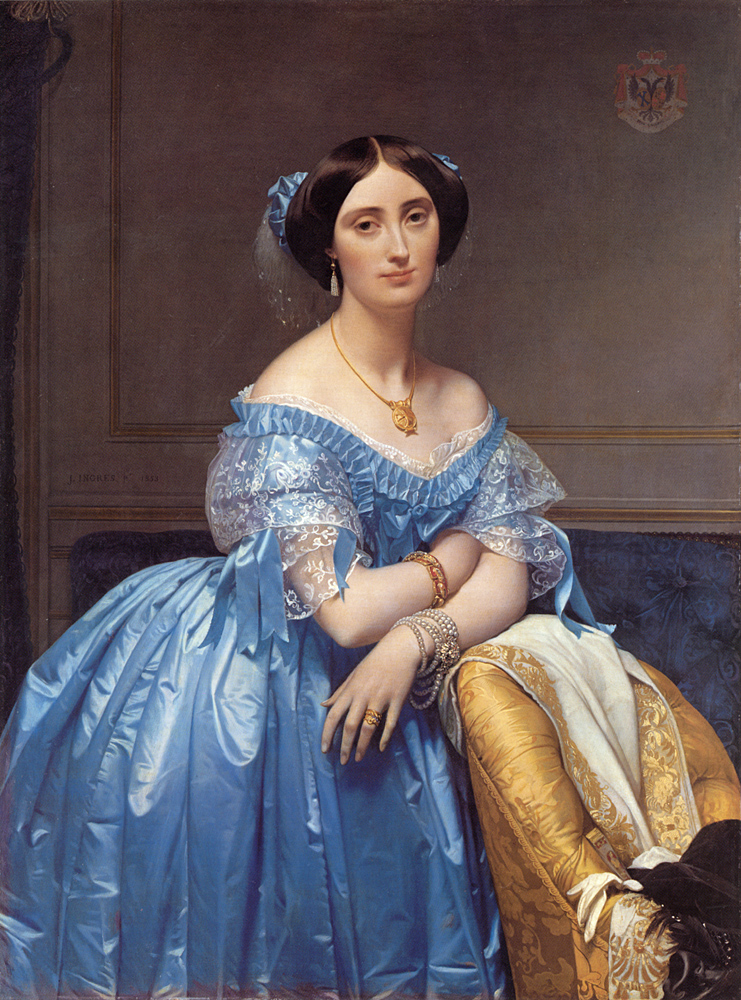Introduction:
 |
| Princess Albert de Broglie: Jean Auguste Dominique Ingres Oil on canvas, size 121.2 × 90.7 cm Metropolitan Museum of Art, Manhattan, New York, USA |
Classicism in Portraiture: The Ancient Foundations of Style
The Origins of Classicism in Art
Classicism refers to the revival of ancient Greek and Roman ideals—clarity, harmony, proportion, and moral gravity—across multiple artistic periods. In portrait painting, this meant emphasizing idealized beauty and balanced compositions rather than spontaneous realism. Figures were often posed with deliberate symmetry and painted with smooth, controlled brushwork.
Renaissance Revival and the Path to Neoclassicism
During the Renaissance, artists like Raphael and Leonardo da Vinci reinterpreted classical ideals for a Christian and humanist age. By the late 18th century, as Europe shifted politically and culturally, Classicism was reborn as Neoclassicism—a direct reaction against Rococo’s frivolity and ornate excess. This movement emphasized moral seriousness, simplicity of form, and a renewed interest in ancient art.
Neoclassical Portrait Painting: Moral Virtue Meets Lifelike Likeness
Defining Features of Neoclassical Portraiture
Neoclassical portraits were more than status symbols; they were statements of personal virtue. Artists emphasized:
-
Sculptural clarity of form
-
Linear precision over painterly looseness
-
Subdued backgrounds to highlight the sitter
-
Antique-inspired costumes or settings to evoke timeless ideals
Jacques-Louis David: The Political Edge of Neoclassicism
 |
| Madame Récamie Jacques-Louis David, Public domain, via Wikimedia Commons |
Ingres’s Approach: The Marriage of Line, Luxury, and Intimacy
Ingres’s Artistic Lineage
Trained in David’s circle, Ingres inherited Neoclassicism’s discipline but added a personal touch—elongated forms, jewel-like surfaces, and an interest in the sitter’s psychology.
The Princess Albert de Broglie: Compositional Analysis
In Princess Albert de Broglie, Ingres positions the sitter in a three-quarter view against a neutral backdrop. Her sumptuous blue satin gown and delicate lace trim shimmer under a controlled light source. Every fold of fabric and strand of hair is meticulously rendered, yet the smooth, unbroken surface erases visible brushwork, creating a flawless, almost enamel-like finish.
Balancing Public Grandeur and Private Reflection
While the jewels, fabrics, and poise affirm the princess’s aristocratic standing, her slightly tilted head and calm yet distant gaze invite the viewer into a quieter emotional space. Ingres achieves a rare duality—formal splendor and personal vulnerability.
Franz Xaver Winterhalter: Glamour and Courtly Spectacle
The Court Portrait as Soft Power
 |
Empress Eugénie of FranceFranz Xaver Winteralter, Public domain,via Wikimedia Commons |
Comparing Winterhalter and Ingres
Where Ingres anchors his sitter in classical restraint, Winterhalter envelops his subjects in a world of courtly fantasy.
Winterhalter’s work celebrates surfaces and spectacle; Ingres’s celebrates structure and serenity.
Classicism vs. Neoclassicism in Portraiture: A Comparative Perspective
David’s Rigor, Ingres’s Refinement, Winterhalter’s Romance
-
David: Emphasized civic virtue, austere composition, and antique references.
-
Ingres: Preserved classical clarity while introducing sumptuous realism and psychological depth.
-
Winterhalter: Adapted classical poise to glamorous theatricality for royal patronage.
How All Three Used Classical Ideals
Even with different aims, all three shared:
-
Emphasis on proportion and balance
-
Careful drawing as a foundation
-
Control of light to sculpt form
-
Use of costume and accessories to communicate status and values
The Cultural Moment: Why Mid-19th-Century Portraits Look This Way
Visual Side-by-Side Comparison
 |
| Princess Albert de Broglie: Jean Auguste Dominique Ingres |
 |
| Empress Eugénie of France Franz Xaver Winterhalter, Public domain, via Wikimedia Commons |
 |
| Madame Récamier Jacques-Louis David, Public domain, via Wikimedia Commons |
David: Minimalist, moralizing, antique.
-
Ingres: Balanced, luxurious, psychologically nuanced.
-
Winterhalter: Decorative, romanticized, socially performative.
Conclusion: The Enduring Power of Neoclassical Portraiture
Ingres’s Princess Albert de Broglie stands at the crossroads of classical discipline and modern intimacy. When viewed alongside David’s moral clarity and Winterhalter’s courtly glamour, it becomes clear how flexible classical aesthetics could be—capable of projecting political virtue, aristocratic splendor, or personal truth.
The painting’s enduring magnetism lies in its fusion of opposites: restraint and richness, formality and feeling, and the timeless and the personal. It remains not only one of Ingres’s most admired portraits but also one of the clearest demonstrations of how Classicism and Neoclassicism shaped the art of seeing—and being seen—in the 19th century.